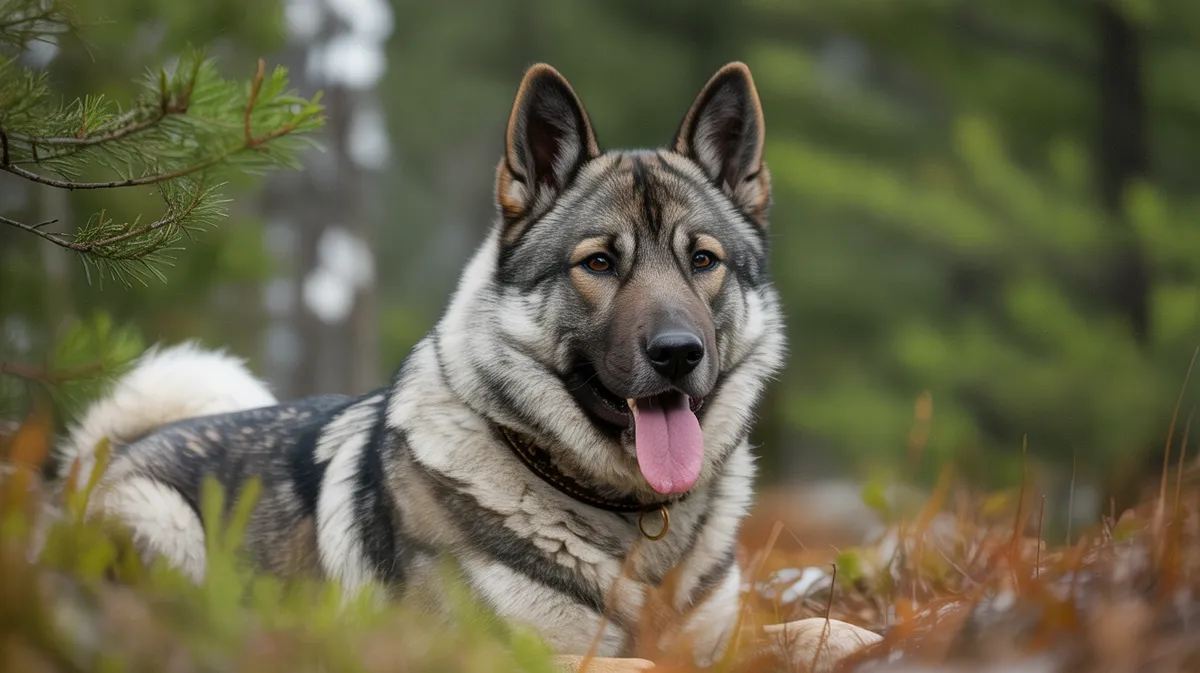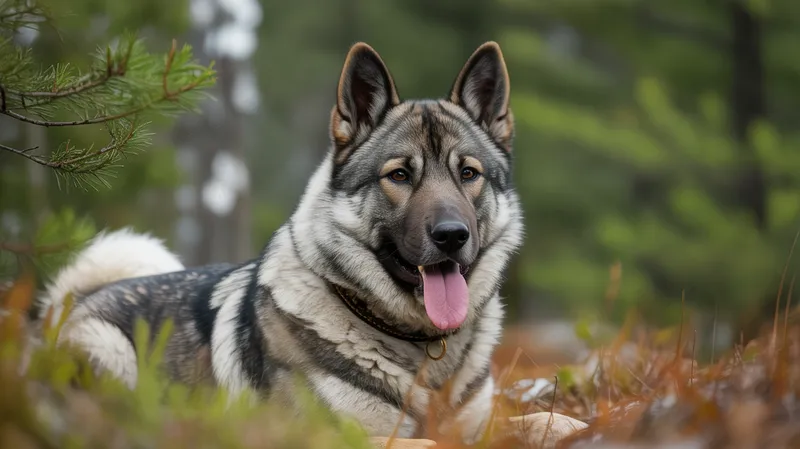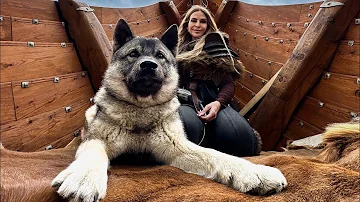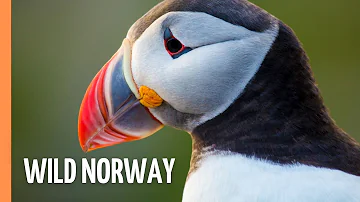
Norwegian Elkhound
Canis lupus familiaris

Meet the Norwegian Elkhound
The Norwegian Elkhound is a robust and versatile spitz-type dog breed originating from Norway, traditionally used for hunting large game such as moose and elk. Renowned for its thick silver-gray coat, curled tail, and pointed ears, this breed is both courageous and loyal, making it an excellent companion and watchdog. Norwegian Elkhounds are athletic, intelligent, and highly energetic, requiring regular exercise and mental stimulation to thrive. Their keen sense of smell and endurance make them exceptional hunters in rugged, forested, and mountainous terrain.
Classification
Mammal
Habitat
Forests, mountains, and rural regions
Diet
Omnivore
Lifespan
12-15 years
Conservation
Least Concern
Weight
18-27 kg (40-60 lbs)
📖Fascinating Facts
Viking Companion
Archaeological evidence shows Norwegian Elkhounds were companions and hunting partners of the Vikings over a thousand years ago.
Exceptional Tracker
Their keen sense of smell and stamina allow them to track and corner large game, alerting hunters with their distinctive baying bark.
Weather-Resistant
The Norwegian Elkhound's dense, weather-resistant coat enables it to thrive in cold, harsh climates typical of Scandinavia.
📋Detailed Description
The Norwegian Elkhound is a medium-sized, powerfully built spitz-type dog, typically standing 49–52 cm (19–20.5 in) at the withers and weighing 20–25 kg (44–55 lbs). Its dense, double-layered coat is weather-resistant, with a woolly undercoat and a coarse, silver-gray outer coat that provides insulation against harsh Scandinavian climates. The breed’s wedge-shaped head, erect triangular ears, and tightly curled tail are characteristic of northern spitz breeds, aiding in heat retention and communication. Norwegian Elkhounds possess a deep chest and muscular limbs, adaptations for stamina and agility in rugged terrain. Their keen olfactory senses are among the sharpest in domestic dogs, enabling them to track large game over long distances. Behaviorally, they are alert, independent, and highly intelligent, often displaying a strong prey drive and territorial instincts. Socially, Elkhounds are pack-oriented, forming close bonds with family members and demonstrating protective behaviors. They are vocal communicators, using a distinctive baying bark to signal the presence of game or intruders. Reproduction is seasonal, with females typically coming into estrus once or twice per year, and litters averaging 5–8 pups. The breed’s longevity is notable, with a typical lifespan of 12–15 years, and they are generally robust, though prone to certain hereditary conditions such as hip dysplasia.
💡 Did you know?
Despite their name, Norwegian Elkhounds are actually specialized in hunting moose, which are called 'elk' in Europe.
🔬Research & Sources
Wikipedia Summary
The Norwegian Elkhound is one of the Northern Spitz-type breeds of dog and is the National Dog of Norway. The Elkhound has served as a hunter, guardian, herder, and defender. It is known for its courage in tracking and hunting elk and other large game, such as bears or wolves. The Norwegian Elkhound was first presented at a dog exhibition in Norway in 1877.
Last Modified: 5/18/2025
🎭Behavior & Social Structure
Norwegian Elkhounds are renowned for their persistence and courage in hunting, historically used to track and hold large game such as moose (elk), bear, and wolf. Their hunting style is characterized by silent tracking followed by loud, sustained barking once the quarry is located, effectively 'holding' the animal in place until the hunter arrives. This vocalization is not only a hunting tool but also a means of communication within the pack and with humans. Elkhounds are highly energetic, requiring substantial daily exercise and mental stimulation; without these, they may develop behavioral issues such as destructiveness or excessive vocalization. Socially, they are loyal and affectionate with family, often forming strong attachments to a primary handler, but can be reserved or aloof with strangers. They exhibit a high degree of independence, a trait selected for in their working history, but are also responsive to positive reinforcement training. Daily routines typically include patrolling their territory, engaging in scent work, and interactive play. Feeding behavior is omnivorous, though they thrive on a high-protein diet reflecting their hunting ancestry.
👶Reproduction & Life Cycle
Norwegian Elkhounds reach sexual maturity at approximately 12–18 months. Females typically come into estrus once or twice annually, with the most common breeding season being late winter to early spring. Courtship involves ritualized behaviors such as sniffing, licking, and playful chasing. After successful mating, gestation lasts about 60–63 days. Litters generally consist of 5–8 puppies, though larger litters are not uncommon. Neonates are born blind and deaf, relying entirely on maternal care for the first two weeks. The dam is attentive, providing warmth, grooming, and feeding. Weaning begins at 3–4 weeks, with puppies gradually transitioning to solid food. Socialization with littermates and humans is critical during the early weeks to ensure well-adjusted adult behavior. Responsible breeders screen for hereditary diseases, particularly hip dysplasia and progressive retinal atrophy, to maintain breed health.
🛡️Adaptations & Survival
The Norwegian Elkhound exhibits several adaptations for survival in cold, forested, and mountainous environments. Its thick, double-layered coat insulates against subzero temperatures and repels moisture, while the curled tail protects the nose and face during rest. The breed’s compact, muscular build provides both endurance and agility, essential for traversing rough terrain and pursuing large game. Erect ears enhance auditory acuity, aiding in the detection of distant sounds. Their highly developed sense of smell, estimated to be tens of thousands of times more sensitive than humans, allows them to track elusive prey over vast distances. Behaviorally, their independence and problem-solving abilities are evolutionary responses to working at a distance from human handlers. Their vocalizations serve both as a hunting adaptation and as a means of social cohesion within packs.
📚Research Sources
🎨Cultural Significance
The Norwegian Elkhound holds a prominent place in Scandinavian culture, recognized as Norway’s National Dog. Archaeological evidence suggests that spitz-type dogs resembling the Elkhound have been present in Norway for over 6,000 years, often associated with Viking settlements and depicted in ancient carvings and artifacts. Historically, the breed was indispensable for hunting large game, providing food and furs vital for survival in harsh northern climates. In folklore, the Elkhound is celebrated for its bravery and loyalty, often symbolizing protection and partnership. The breed continues to participate in traditional hunting, dog shows, and as a family companion, embodying national pride and cultural heritage.
🔬Recent Research & Discoveries
Recent genetic studies have confirmed the ancient lineage of the Norwegian Elkhound, placing it among the oldest domesticated dog breeds in Europe. Research into canine olfaction has highlighted the Elkhound’s exceptional scent-tracking abilities, making it a model for studies on working dog performance and olfactory genetics. Ongoing veterinary research focuses on the prevalence and management of hereditary diseases within the breed, with advances in genetic screening improving breeding practices. Behavioral studies have examined the breed’s independence and problem-solving skills, contributing to broader understanding of working dog cognition. Conservation genetics projects are underway in Scandinavia to monitor genetic diversity and prevent inbreeding.
🎥Wildlife Videos

THE NORWEGIAN ELKHOUND - Powerful Hunting Dog of NORWAY
The Norwegian Elkhound aka The Norsk Elghund is Noway's National Treasure but he's also a fierce hunter of moose, elks and ...
Animal Watch

Save the Rarest Dog Breed Norwegian Elkhound from EXTINCTION!
The video explores the rich history and importance of Norwegian Elkhounds, emphasizing preservation through proper breeding ...
Dogumentary TV

Wild Canada - Nature's Untamed Beauty | Full Series | Free Documentary Nature
Wild Canada - Nature's Untamed Beauty | Wildlife Documentary Watch 'Darkwoods - Canada's Hidden Nature Reserve' here: ...
Free Documentary - Nature

A Winter Wildlife Wonderland | BBC Earth
Take a journey through magical winter landscapes, exploring the wondrous and wild animals that live there. Watch as they grow ...
BBC Earth

Fjords, Fells, and Wildlife: Exploring Norway | Full Epsiode
Norway's fjords and fells are among the most spectacular of what Europe has to offer. Its wildlife is outstanding. In spring, herds of ...
Free High-Quality Documentaries

The Baltic | Survival in a Pristine Ecosystem | Animal documentary
Welcome to "The Baltic | Survival in a Pristine Ecosystem", a captivating wildlife documentary that transports you to the serene yet ...
WILD NATURE - Nature animal documentary
🌍Habitat Information
The Norwegian Elkhound typically inhabits Forests, mountains, and rural regions environments. Norwegian Elkhounds have adapted to their environments with specialized features and behaviors.
Primary Habitat:
Forests, mountains, and rural regions
More detailed habitat information will be available soon.
🛡️Conservation Status
The Norwegian Elkhound is currently classified as Least Concern. Conservation efforts are crucial for preserving this species for future generations.
Common Threats:
- 🏠Habitat loss and fragmentation
- 🌡️Climate change impacts
- 🎯Hunting and poaching
- 🏭Human-wildlife conflict
⚠️Threats & Conservation Challenges
The Norwegian Elkhound is currently classified as 'Least Concern' in terms of conservation status, with stable populations globally due to its popularity as a companion and working dog. However, the breed faces several challenges, including a limited gene pool in some regions, leading to increased incidence of hereditary diseases such as hip dysplasia, progressive retinal atrophy, and hypothyroidism. Urbanization and changes in hunting practices have reduced opportunities for traditional working roles, potentially impacting behavioral health if exercise and stimulation needs are unmet. There are no significant threats from habitat loss or direct human persecution, but responsible breeding and health screening are ongoing concerns. Population trends remain stable, though vigilance is needed to maintain genetic diversity and breed health.
🔬Scientific Classification
Scientific Name
Canis lupus familiaris
Classification Hierarchy
🔍 About Taxonomic Classification
Taxonomic classification is a hierarchical system used by scientists to classify and organize living organisms based on shared characteristics and evolutionary relationships.
The system moves from broad categories (Kingdom) to increasingly specific ones, with each animal's scientific name typically consisting of its Genus and species.
📝Community Notes
Share your observations and insights about the Norwegian Elkhound with our community of wildlife enthusiasts.
Join Our Community
Sign in to share your observations and connect with fellow wildlife enthusiasts.
Sign In to ContributeNo community notes yet
Be the first to share your observations about the Norwegian Elkhound!
Explore Norwegian Elkhound
Select a tab above to learn more about this amazing animal.
📸Photo Gallery
No photos available for this animal yet.
🌟Discover More Wildlife
Continue your journey of discovery with more fascinating animals from our database
